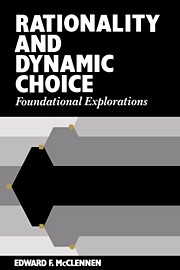Book contents
- Frontmatter
- Contents
- Conditions on orderings and acceptable-set functions
- Acknowledgments
- 1 Introduction and sketch of the main argument
- 2 The ordering principle
- 3 The independence principle
- 4 The problem of justification
- 5 Pragmatic arguments
- 6 Dynamic choice problems
- 7 Rationality conditions on dynamic choice
- 8 Consequentialist constructions
- 9 Reinterpreting dynamic consistency
- 10 A critique of the pragmatic arguments
- 11 Formalizing a pragmatic perspective
- 12 The feasibility of resolute choice
- 13 Connections
- 14 Conclusions
- 15 Postscript: projections
- Notes
- Bibliography
- Author index
- Subject index
11 - Formalizing a pragmatic perspective
Published online by Cambridge University Press: 05 February 2012
- Frontmatter
- Contents
- Conditions on orderings and acceptable-set functions
- Acknowledgments
- 1 Introduction and sketch of the main argument
- 2 The ordering principle
- 3 The independence principle
- 4 The problem of justification
- 5 Pragmatic arguments
- 6 Dynamic choice problems
- 7 Rationality conditions on dynamic choice
- 8 Consequentialist constructions
- 9 Reinterpreting dynamic consistency
- 10 A critique of the pragmatic arguments
- 11 Formalizing a pragmatic perspective
- 12 The feasibility of resolute choice
- 13 Connections
- 14 Conclusions
- 15 Postscript: projections
- Notes
- Bibliography
- Author index
- Subject index
Summary
Introduction
The examples discussed in Chapter 10 suggest that agents who use methods of evaluation that violate either the CFO factor of WO (or CF) or IND (or CIND), and who thus cannot satisfy all of DC, NEC, and SEP in certain dynamic choice situations, do not necessarily fall into pragmatic difficulties – that such difficulties are reserved for those who approach these choice situations in a myopic manner. Three questions naturally arise here. First, does taking a myopic approach invariably make one subject to such difficulties? Second, does taking either a sophisticated or a resolute approach enable one to avoid whatever pragmatic difficulties arise for those who adopt a myopic approach? Third, does one of these alternative approaches turn out to be superior to the other from a pragmatic perspective?
I shall argue in response to the first two questions that it is in fact not true that agents who employ methods of evaluation that violate either CFO or IND can always be caught up in pragmatic difficulties. Violations of these two principles need not result in choice of a plan whose associated prospect is dominated with respect to sure outcomes by the prospect associated with some other feasible plan. To be sure, an agent who does employ such methods of evaluation and who deals with the ensuing problem of dynamic consistency in a myopic manner typically (perhaps even invariably) can be caught up in such a pragmatic difficulty.
- Type
- Chapter
- Information
- Rationality and Dynamic ChoiceFoundational Explorations, pp. 183 - 199Publisher: Cambridge University PressPrint publication year: 1990

